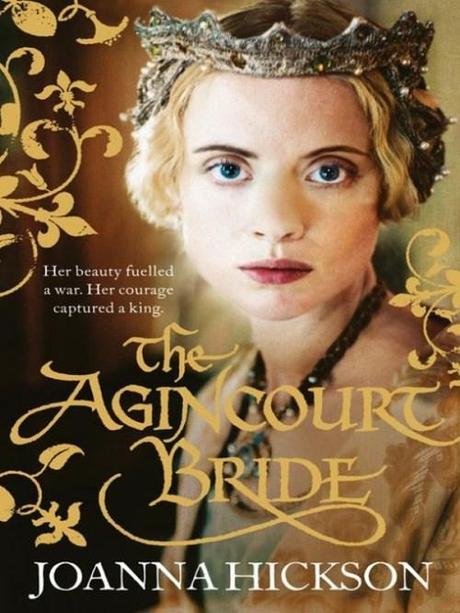
I’ve been completely fascinated by Catherine de Valois ever since I was a very little girl and read my grandmother’s copy of Rosemary Hawley Jarman’s Crown in Candlelight, which was an occasionally unsuitably racy tale of a forgotten princess, brought up in rags and relative poverty, who is scrubbed up and married off as the spoils of war to the rather lovely Henry V (one of my first historical crushes!) but is then promptly widowed at the age of just twenty one and left alone and vulnerable with a baby son. She then consoles herself with a handsome Welshman, whom she may or may not have married and the rest, as we all know, is Tudor History.
It’s a compelling tale of rags to riches, evil Queens, wicked courtiers, war and true love but how much of it is actually true? For a start, as with that other famous bad mother of Tudor lore, Frances Grey, historians have recently started to challenge the notion that Isabeau of Bavaria, Queen of France and mother of Catherine and her siblings, was a neglectful parent who left her children to fend for themselves while she swanned off to have affairs with, well, pretty much everyone and only took an interest in their well being when it was of benefit to her. In fact we now know that actually the Valois royal children were well looked after and showered with lavish clothes and gifts from their mother, whose absence from their lives wasn’t actually all that unusual considering her status and the times they lived in.
Also was Henry V as infatuated with the undoubtedly rather lovely Catherine as we are led to believe or is that yet another one of Shakespeare’s inventions? After all, he left her after only a couple of days of marriage to keep an eye on yet another one of his sieges and the rest of their brief marriage followed much the same pattern with the couple actually spending only a few months together in all thanks to his military campaigning. Henry was even absent in France when she gave birth to their only child, Henry in December 1421. Perhaps things would have been different when he was older and happy to leave the warmongering side of the family business to their sons but sadly Catherine never got to found out as just over two years after their wedding day in June 1420, Henry was dead, having never even seen his infant son, who now succeeded him as Henry VI.

The wedding of Henry V and Catherine de Valois. Photo: British Library.
Still, despite all this, I’m surprised that Catherine’s story hasn’t been the focus of more historical fiction (I’ve often thought about writing about her myself but it’s pretty low down on my list of Books I Plan To Write, alas) so I was really pleased to see Joanna Hickson’s The Agincourt Bride pop up on Amazon and quickly pre-ordered it for my Kindle.
I’m very pleased that I did as I really enjoyed this book. As is the current trend, the story is narrated not by Catherine herself but by her nurse maid, the faithful and rather too adoring Mette Lanière who becomes her wet nurse at the age of fifteen after her own son is born dead. I’ll admit now that I don’t actually usually like books about historical people that are told from the point of view of one of their more humbly born and usually fictitious contemporaries – I’m not sure why, I think I just find it distracting, distancing and unnecessary although I can see why authors have started doing it. However, for once, I really enjoyed Mette’s account of Catherine’s story and her own terrible travails as she does her best to protect not just her young charge from the war, rebellion and betrayal that surrounds her but also look after and raise her own family.
Catherine herself is portrayed here as rather too good to be true, all flowing gold tresses, wide blue eyes and gentle sweet nature. I liked her though and definitely preferred her when a bit of steel crept into her character and she started to show a bit of backbone to her awful mother and other relatives, in particular the loathsome Jean sans Peur, Duke of Burgundy, who is depicted as blacker than black and the very worst sort of villain, who preys on and abuses the young Catherine while at the same time making up to her mother and scheming against her brother.

Laurence Olivier and Renée Asherson as Henry V and Catherine de Valois in Henry V, 1944.
For me the book really took off when Henry V, who remains one of my favorite kings alongside Charles II and Edward VII, made his first appearance – I was rather smitten with Hickson’s depiction of him as handsome, charming, ruthless, devout but fundamentally clueless when it comes to dealing with his beautiful young wife. I’m now really looking forward to the follow up novel The Tudor Bride, which is due out this autumn and will take up the story where it ended in The Agincourt Bride as Catherine, her new husband and Mette make their way from France to England for her coronation.
The cover makes this look like a Philippa Gregory and I’d definitely say that this is quite similar to her books in as much as it’s about a princess in the fifteenth century, although I enjoyed it rather more than her recent novels. All in all this was an enjoyable read, especially for fans of Henry V. Oh sigh.
